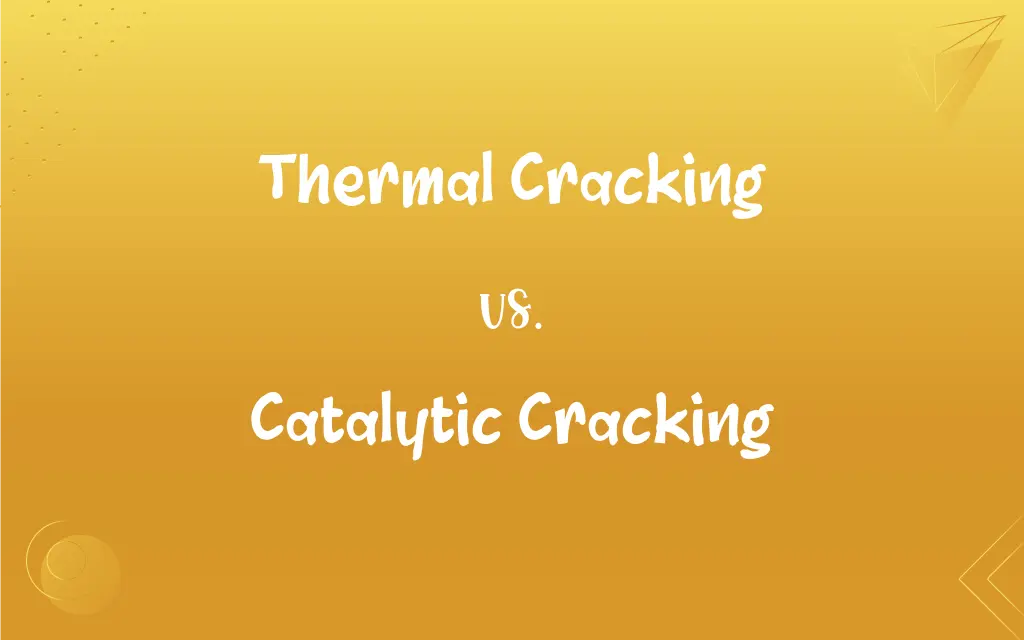Thermal Cracking vs. Catalytic Cracking: What's the Difference?
Edited by Aimie Carlson || By Janet White || Published on December 21, 2023
Thermal cracking breaks down large hydrocarbon molecules by heat, producing smaller molecules. Catalytic cracking uses a catalyst to achieve the same, but at lower temperatures and with more control over the product types.

Key Differences
Thermal cracking is an older petroleum refining process that uses high temperatures, often above 500°C, to break down larger hydrocarbon molecules into smaller ones. It is primarily used to produce light hydrocarbons, gasoline, and diesel fuels. Catalytic cracking, on the other hand, incorporates a catalyst to facilitate the breakdown of hydrocarbon molecules. This process occurs at relatively lower temperatures than thermal cracking, usually around 450-500°C. The catalyst improves the efficiency and specificity of the cracking process.
The output of thermal cracking is less predictable and often includes a higher percentage of undesirable byproducts like coke and gases. It operates under severe conditions, typically high temperatures and pressures, leading to more energy consumption and equipment stress. Conversely, catalytic cracking produces a higher yield of valuable products like gasoline and lighter hydrocarbons due to the specificity offered by the catalyst. This process also generates less coke and unwanted gases, making it more environmentally friendly and cost-effective.
The technology of thermal cracking is simpler and has been around since the early 20th century. It has lesser hardware complexities but is less efficient in converting heavy hydrocarbons into lighter fractions. Catalytic cracking technology, emerging later, revolutionized the petroleum industry with its ability to produce higher-quality products from the same feedstock. The catalysts used, often zeolites, can be regenerated and reused, making the process more sustainable and economical over time.
Thermal cracking's indiscriminate breaking of carbon bonds can result in a range of product sizes and types, often requiring further processing. Catalytic cracking, meanwhile, offers more control over the end products. The presence of a catalyst allows for selective breaking of bonds, leading to a more uniform distribution of product sizes and types, which are typically more valuable in the market.
Both processes aim to break down larger hydrocarbon molecules into smaller, more useful ones, thermal cracking does so purely with heat and pressure, resulting in a less controlled and efficient process. Catalytic cracking, utilizing a catalyst, offers greater control, efficiency, and environmental friendliness, producing higher yields of desired products like gasoline and minimizing unwanted byproducts.
ADVERTISEMENT
Comparison Chart
Process Mechanism
Uses heat and pressure to break down molecules.
Uses a catalyst along with heat for cracking.
Operating Conditions
High temperatures (above 500°C) and pressures.
Lower temperatures (450-500°C), often under pressure.
Product Yield
Less predictable, higher in gases and coke.
Higher in valuable products like gasoline.
Environmental Impact
Higher emissions, more byproducts.
Lower emissions, less byproducts.
Technological Complexity
Simpler, less equipment required.
More complex, requires catalyst handling.
ADVERTISEMENT
Thermal Cracking and Catalytic Cracking Definitions
Thermal Cracking
Thermal cracking involves breaking down large hydrocarbon molecules through high heat.
In thermal cracking, heavier crude oil fractions are converted into gasoline and diesel.
Catalytic Cracking
Catalytic cracking operates around 450-500°C, utilizing zeolite catalysts.
Modern refineries prefer catalytic cracking for its controlled outcomes.
Thermal Cracking
It's an older, less efficient method compared to catalytic cracking.
Thermal cracking was the primary method before the advent of catalytic processes.
Catalytic Cracking
It enhances the production of gasoline and lighter hydrocarbons.
The refinery switched to catalytic cracking for better gasoline yield.
Thermal Cracking
It's a process used in petroleum refineries to produce lighter hydrocarbons.
Thermal cracking is essential for meeting the high demand for gasoline.
Catalytic Cracking
It's a more technologically advanced and efficient refining process.
The shift to catalytic cracking increased the refinery's profitability.
Thermal Cracking
This method applies extreme temperatures to 'crack' molecular bonds.
Thermal cracking can inadvertently produce unwanted byproducts like coke.
Catalytic Cracking
Catalytic cracking uses a catalyst to break down hydrocarbons at lower temperatures.
Catalytic cracking revolutionized fuel production with its efficiency.
Thermal Cracking
Thermal cracking operates at temperatures typically above 500°C.
The refinery uses thermal cracking to maximize fuel production.
Catalytic Cracking
This process reduces environmental impact compared to thermal cracking.
Catalytic cracking is favored for its lower emissions and byproducts.
FAQs
What is the main disadvantage of thermal cracking?
It's less efficient and produces a higher percentage of undesirable byproducts.
What is thermal cracking?
It's a process of breaking down large hydrocarbon molecules using high heat.
Is thermal cracking environmentally friendly?
It produces more emissions and byproducts compared to catalytic cracking.
What are the benefits of catalytic cracking?
It's more efficient, produces higher-quality products, and is environmentally friendlier.
What catalysts are used in catalytic cracking?
Commonly, zeolites are used as catalysts.
Can the catalysts in catalytic cracking be reused?
Yes, they can be regenerated and reused.
Is catalytic cracking more technologically advanced than thermal cracking?
Yes, it involves more complex technology and equipment.
What is the significance of the catalyst in catalytic cracking?
It increases the efficiency and specificity of the cracking process.
What temperatures are involved in thermal cracking?
It operates at temperatures above 500°C.
How does thermal cracking affect the refinery's energy consumption?
It consumes more energy due to higher temperatures and pressures.
What products are obtained from thermal cracking?
It typically produces lighter hydrocarbons like gasoline and diesel.
What is catalytic cracking?
It's a process that uses a catalyst to break down hydrocarbons at lower temperatures.
Can catalytic cracking be used for heavy crude fractions?
Yes, it's effective in processing heavy fractions into lighter, more valuable products.
What is the main product of thermal cracking?
It primarily produces gasoline and diesel fuels.
Can thermal cracking produce lighter hydrocarbons?
Yes, but with less efficiency and more byproducts compared to catalytic cracking.
What environmental benefits does catalytic cracking offer?
It generates fewer emissions and undesirable byproducts.
What role does temperature play in thermal cracking?
Higher temperatures are crucial for breaking molecular bonds in thermal cracking.
How does catalytic cracking improve product quality?
It allows for more control over the end products, producing more valuable hydrocarbons.
How does the choice of catalyst affect catalytic cracking?
The type of catalyst used can influence the yield and quality of the products.
How has catalytic cracking impacted the petroleum industry?
It has significantly improved the efficiency and quality of petroleum refining processes.
About Author
Written by
Janet WhiteJanet White has been an esteemed writer and blogger for Difference Wiki. Holding a Master's degree in Science and Medical Journalism from the prestigious Boston University, she has consistently demonstrated her expertise and passion for her field. When she's not immersed in her work, Janet relishes her time exercising, delving into a good book, and cherishing moments with friends and family.
Edited by
Aimie CarlsonAimie Carlson, holding a master's degree in English literature, is a fervent English language enthusiast. She lends her writing talents to Difference Wiki, a prominent website that specializes in comparisons, offering readers insightful analyses that both captivate and inform.






































































